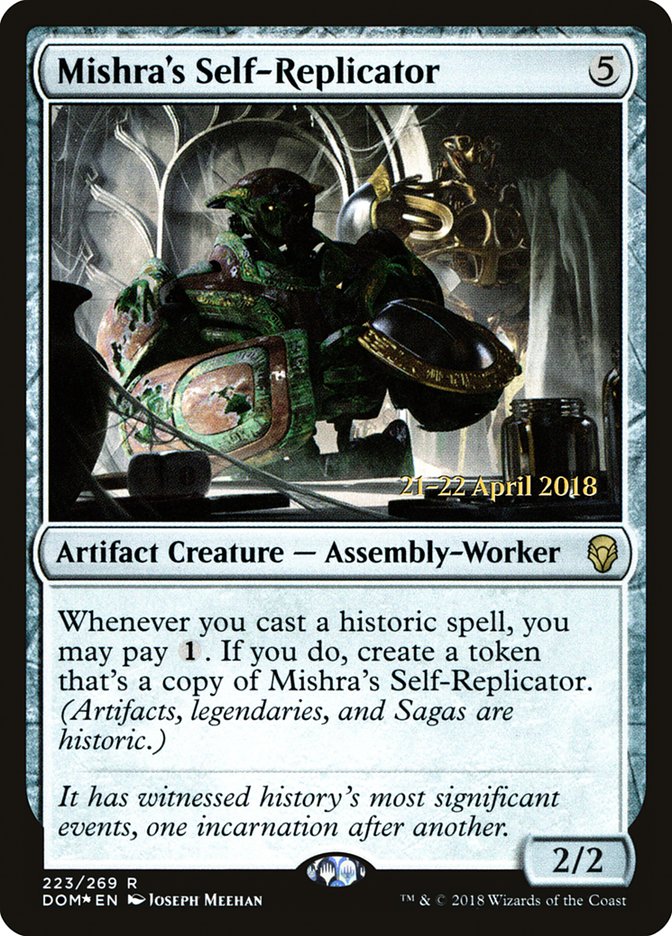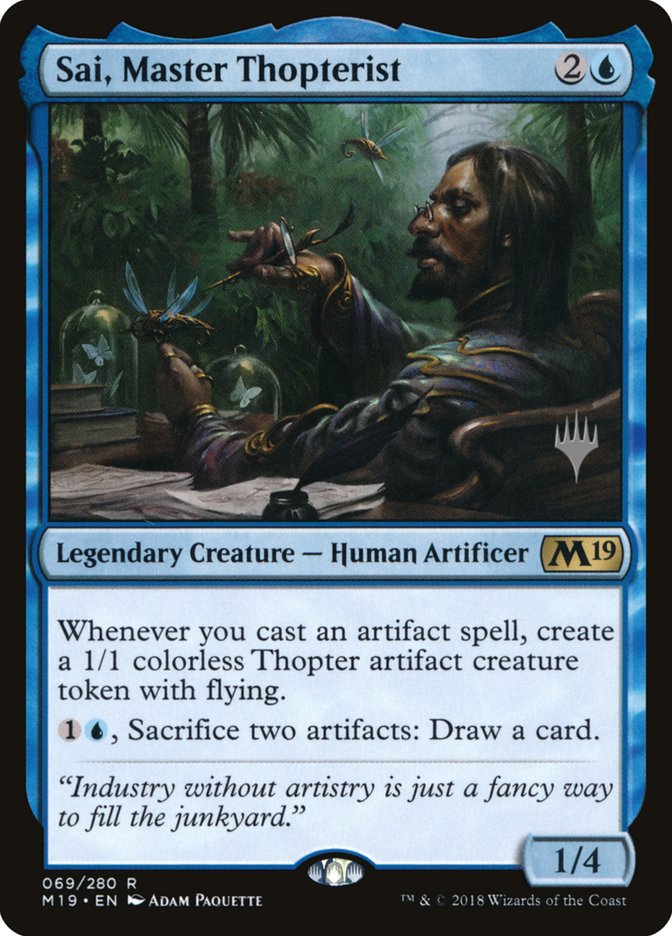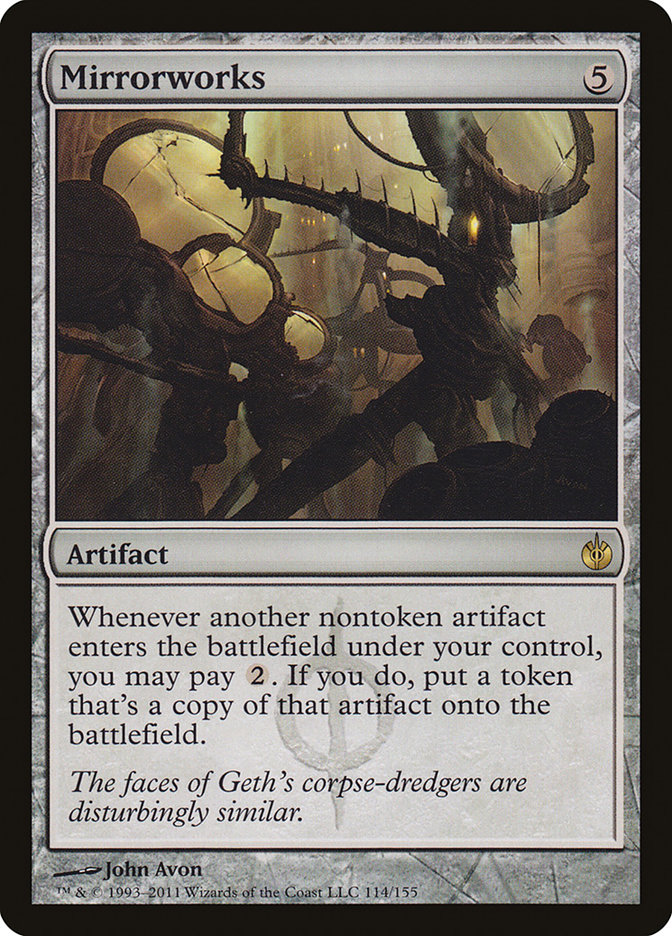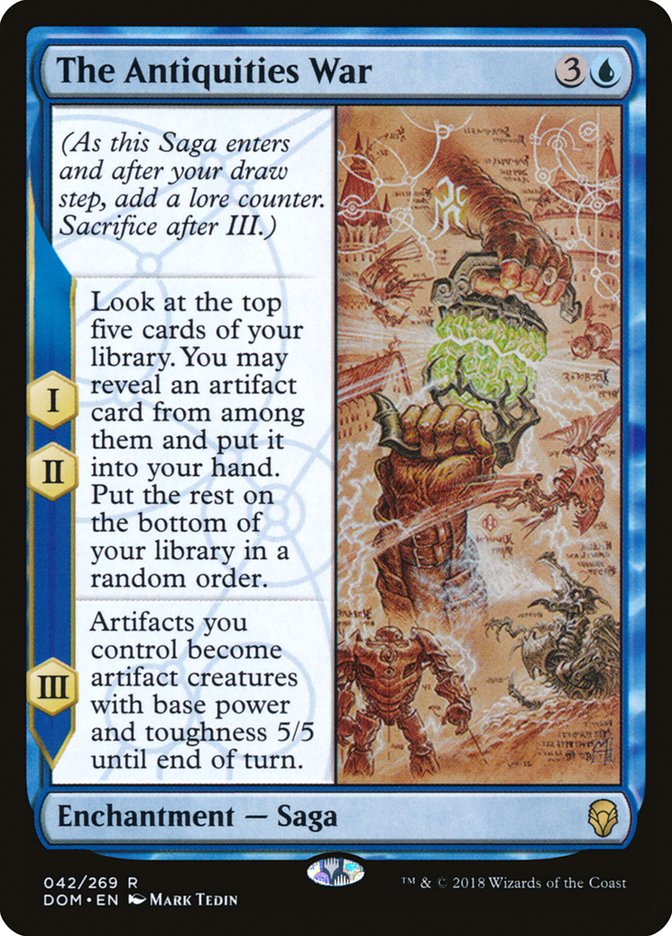Mishra's Self-Replicator MTG Card
| Card sets | Released in 3 setsSee all |
| Mana cost | |
| Converted mana cost | 5 |
| Rarity | Rare |
| Type | Artifact Creature — Assembly-Worker |
| Power | 2 |
| Toughness | 2 |
Text of card
Whenever you cast a historic spell, you may pay . If you do, create a token that's a copy of Mishra's Self-Replicator. (Artifacts, legendaries, and Sagas are historic.)
It has witnessed history's most significant events, one incarnation after another.
Cards like Mishra's Self-Replicator
Mishra’s Self-Replicator offers a novel spin on creature-based strategies in Magic: The Gathering, not unlike the card Sai, Master Thopterist. Both cards have abilities that capitalize on casting artifacts – while Sai creates Thopter tokens when you cast an artifact, Mishra’s Self-Replicator lets you pay one to duplicate itself, potentially overwhelming your opponent with a legion of Self-Replicators.
Similarly, Mirrorworks echoes this thematic by allowing you to create a copy of any nontoken artifact that enters the battlefield under your control, but at a higher upfront cost per artifact. Though Mirrorworks isn’t a creature, it’s a flexible engine in artifact-centric decks. Conversely, the Self-Replicator requires consecutive artifact plays to duplicate, but this can form an unstoppable army over time if left unchecked.
Lastly, we come across The Antiquities War, a saga which digs deep into your library for artifacts and, akin to Mishra’s Self-Replicator, has the power to dramatically alter the board state. While the saga’s later effects are temporary, Mishra’s Self-Replicator’s impact can last much longer, providing a persistent threat. Each of these cards offer inventive ways to leverage your artifacts, yet Mishra’s Self-Replicator stands out for its replication potential.
Card Pros
Card Advantage: With each artifact spell you cast, Mishra’s Self-Replicator offers the potential to create a copy of itself. This ability to replicate not only builds a formidable board presence but also ensures that you have a consistent stream of artifact creatures, maintaining or even expanding your card advantage over time.
Resource Acceleration: Each copy of Mishra’s Self-Replicator can further catalyze your artifact synergy, helping you to snowball into an overwhelming force. This is especially beneficial in decks that capitalize on artifact strategies, as it accelerates your gameplay by providing additional artifacts to use with abilities or for mana generation.
Instant Speed: Although Mishra’s Self-Replicator doesn’t function at instant speed itself, its replication ability can be triggered during your main phase after assessing your options. This allows for strategic flexibility, ensuring you can react to the board state effectively, creating new copies when the timing is just right.
Card Cons
Discard Requirement: Mishra’s Self-Replicator demands a card to be discarded whenever it reproduces, which can significantly deplete your hand, especially in games where card advantage is crucial.
Specific Mana Cost: This artifact creature requires not only five generic mana but also a heavy investment in artifact or colorless mana sources to consistently replicate itself, potentially straining your deck’s mana base.
Comparatively High Mana Cost: For a creature that initially enters the battlefield as a 2/2, the cost of five mana might be too steep, considering that there are more cost-effective creatures or spells that could be played with the same resources.
Reasons to Include Mishra’s Self-Replicator in Your Collection
Versatility: Mishra’s Self-Replicator augments a variety of deck archetypes, excelling in strategies that capitalize on artifact synergies. Its ability to create copies of itself can create significant board presence across multiple turns.
Combo Potential: This card shines in an engine that churns out artifacts, allowing you to replicate it numerous times. Pairing it with cost reduction and token doublers can lead to an overwhelming tide of replicating constructs.
Meta-Relevance: In a game environment where artifacts are key, Mishra’s Self-Replicator can quickly become a must-answer threat. Integrating it into your deck ensures that you stay competitive and can exploit the common reliance on artifacts in various formats.
How to beat
Mishra’s Self-Replicator presents an interesting dynamic in MTG gameplay, offering the ability to create a stream of artifact creature tokens. This card requires a strategic approach to combat its progressive board presence. One effective method is using removal spells that target multiple creatures or artifacts at once. Cards such as Shatterstorm or Vandalblast can dismantle the replicating army before it overwhelms you. Additionally, countering the initial spell with a card like Dovin’s Veto prevents the replicator from ever hitting the board.
Another angle is to apply pressure early in the game. Aggressive decks can overwhelm an opponent before they get a chance to set up their self-replicating strategy. Creature removal, bounce spells, and even hand disruption are all valuable tactics. Thoughtseize or Inquisition of Kozilek can pluck the replicator from an unwary player’s grip, delaying or outright stopping the threat. Ultimately, while Mishra’s Self-Replicator can be a formidable engine, a proactive and disruption-focused approach should keep it in check, ensuring your continued dominance on the battlefield.
Where to buy
If you're looking to purchase Mishra's Self-Replicator MTG card by a specific set like Dominaria Promos and Dominaria, there are several reliable options to consider. One of the primary sources is your local game store, where you can often find booster packs, individual cards, and preconstructed decks from current and some past sets. They often offer the added benefit of a community where you can trade with other players.
For a broader inventory, particularly of older sets, online marketplaces like TCGPlayer, Card Kingdom and Card Market offer extensive selections and allow you to search for cards from specific sets. Larger e-commerce platforms like eBay and Amazon also have listings from various sellers, which can be a good place to look for sealed product and rare finds.
Additionally, Magic’s official site often has a store locator and retailer lists for finding Wizards of the Coast licensed products. Remember to check for authenticity and the condition of the cards when purchasing, especially from individual sellers on larger marketplaces.
Below is a list of some store websites where you can buy the Mishra's Self-Replicator and other MTG cards:
 BUY NOW
BUY NOW BurnMana is an official partner of TCGPlayer
- eBay
- Card Kingdom
- Card Market
- Star City Games
- CoolStuffInc
- MTG Mint Card
- Hareruya
- Troll and Toad
- ABU Games
- Card Hoarder Magic Online
- MTGO Traders Magic Online
See MTG Products
Printings
The Mishra's Self-Replicator Magic the Gathering card was released in 3 different sets between 2018-04-27 and 2018-04-27. Illustrated by Joseph Meehan.
| # | Released | Name | Code | Symbol | Number | Frame | Layout | Border | Artist |
|---|---|---|---|---|---|---|---|---|---|
| 1 | 2018-04-27 | Dominaria Promos | PDOM | 223s | 2015 | Normal | Black | Joseph Meehan | |
| 2 | 2018-04-27 | Dominaria | DOM | 223 | 2015 | Normal | Black | Joseph Meehan | |
| 3 | The List | PLST | DOM-223 | 2015 | Normal | Black | Joseph Meehan |
Legalities
Magic the Gathering formats where Mishra's Self-Replicator has restrictions
| Format | Legality |
|---|---|
| Historicbrawl | Legal |
| Historic | Legal |
| Legacy | Legal |
| Oathbreaker | Legal |
| Gladiator | Legal |
| Pioneer | Legal |
| Commander | Legal |
| Modern | Legal |
| Vintage | Legal |
| Duel | Legal |
| Explorer | Legal |
| Penny | Legal |
| Timeless | Legal |
Rules and information
The reference guide for Magic: The Gathering Mishra's Self-Replicator card rulings provides official rulings, any errata issued, as well as a record of all the functional modifications that have occurred.
| Date | Text |
|---|---|
| 2018-04-27 | A card, spell, or permanent is historic if it has the legendary supertype, the artifact card type, or the Saga subtype. Having two of those qualities doesn’t make an object more historic than another or provide an additional bonus—an object either is historic or it isn’t. |
| 2018-04-27 | An ability that triggers “whenever you cast a historic spell” doesn’t trigger if a historic card is put onto the battlefield without being cast. |
| 2018-04-27 | If Mishra’s Self-Replicator leaves the battlefield before its triggered ability resolves, the token will still enter the battlefield as a copy of Mishra’s Self-Replicator, using Mishra’s Self-Replicator’s copiable values from when it was last on the battlefield. |
| 2018-04-27 | Lands are never cast, so abilities that trigger “whenever you cast a historic spell” won’t trigger if you play a legendary land. They also won’t trigger if a card on the battlefield transforms into a legendary land, as the Ixalan and Rivals of Ixalan double-faced cards do. |
| 2018-04-27 | Some abilities trigger “whenever you cast a historic spell.” Such an ability resolves before the spell that caused it to trigger. It resolves even if that spell is countered. |
| 2018-04-27 | The token will have Mishra’s Self-Replicator’s ability. It will also be able to create copies of itself. |
| 2018-04-27 | The token won’t copy counters or damage marked on Mishra’s Self-Replicator, nor will it copy other effects that have changed Mishra’s Self-Replicator’s power, toughness, types, color, and so on. Normally, this means the token will simply be a Mishra’s Self-Replicator, but if any copy effects have affected that Mishra’s Self-Replicator, they’re taken into account. |
| 2018-04-27 | While resolving the triggered ability of Mishra’s Self-Replicator, you can’t pay multiple times to create more than one token. However, if you control more than one Mishra’s Self-Replicator, you can pay for each of their abilities. |





